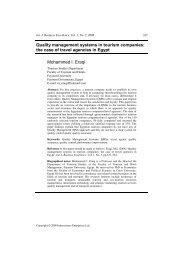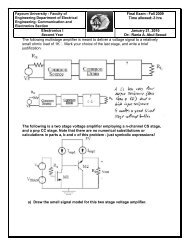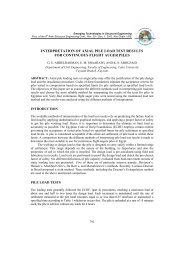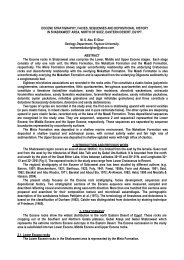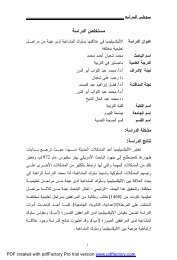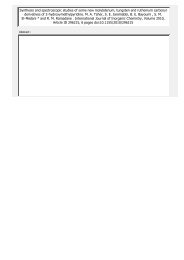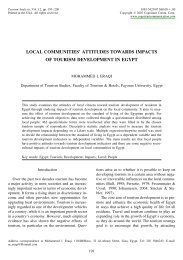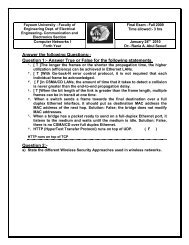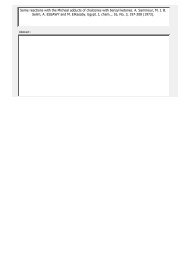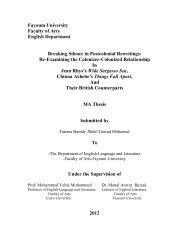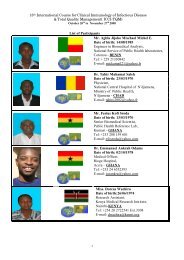EFFECTS OF FIBER ORIENTATION AND LAMINATE STACKING ...
EFFECTS OF FIBER ORIENTATION AND LAMINATE STACKING ...
EFFECTS OF FIBER ORIENTATION AND LAMINATE STACKING ...
Create successful ePaper yourself
Turn your PDF publications into a flip-book with our unique Google optimized e-Paper software.
It is essential to know the vibration characteristics of<br />
these structures, which may be subjected to dynamic<br />
loads in complex environmental conditions. If the<br />
frequency of the loads variation matches one of the<br />
resonance frequencies of the structure, large<br />
translation/torsion deflections and internal stresses<br />
can occur, which may lead to failure of structure<br />
components. In order to achieve the right<br />
combination of material properties and service<br />
performance, the dynamic behavior is one of the<br />
main points to be considered. To avoid the typical<br />
problems caused by vibrations, it is important to<br />
determine: a) the natural frequencies of the structure<br />
and b) the modal shapes to reinforce the most<br />
flexible regions or to locate the right positions where<br />
weight should be reduced or damping should be<br />
increased. With respect to these dynamic aspects, the<br />
composite materials represent an excellent possibility<br />
to design components with requirements of dynamic<br />
behavior as mentioned by (Tita et al., 2003). A<br />
variety of structural components made of composite<br />
materials such as turbine blades, vehicle axles,<br />
aircraft wing, and helicopter blade can be<br />
approximated as laminated composite beams, which<br />
requires a deeper understanding of the vibration<br />
characteristics of the composite beams as mentioned<br />
by (Kapuria and Alam, 2006).<br />
Due to the composite beams widely used in a variety<br />
of structures as well as their substantial benefits and<br />
great promise for future application, the dynamic<br />
behaviors of the laminated composite beams have<br />
received widespread attention and have been<br />
investigated extensively by many researchers. A<br />
number of researchers have been developed<br />
numerous solution methods to analysis the dynamic<br />
behaviors of the laminated composite beams (Khdeir<br />
and Reddy, 1994), (Krishnaswamy et al., 1992), and<br />
(Matsunaga, H., 2001).<br />
The classical laminated beam theory, developed by<br />
Euler-Bernoulli, is used only for thin beams because<br />
this theory has neglected both transverse shear and<br />
normal strains and it is inaccurate for a moderately<br />
deep laminated beam with relatively soft transverse<br />
shear modulus and for highly anisotropic composites.<br />
The inaccuracy is due to neglecting the transverse<br />
shear and normal strains in the laminate. In order to<br />
take into account the effects of low ratio of<br />
transverse shear modulus to the in-plane modulus,<br />
the first order shear deformation theory of<br />
Timoshenko has been developed (Matsunaga, H.,<br />
2001). However, since in the theory the transverse<br />
shear strain is assumed to be constant in the depth<br />
direction, a shear correction factor has to be<br />
incorporated to adjust the transverse shear stiffness<br />
for studying the dynamic problems of beams<br />
(Matsunaga, H., 2001). The accuracy of solutions of<br />
the first order shear deformation theory will be<br />
strongly dependent on predicting better estimates for<br />
the shear correction factor (Matsunaga, H., 2001).<br />
Theoretical analyses of flexural vibration of layered<br />
beams have been studied by several researchers.<br />
Miller and Adams (1975) have been studied the<br />
vibration characteristics of orthotropic clamped-free<br />
beams without including the effect of the shear<br />
deformation. Bhimaraddi and Chandrashekhara<br />
(1991) considered the modeling of laminated beams<br />
by a systematic reduction of the constitutive relations<br />
of the three-dimensional anisotropic body and<br />
concluded that these relations should be adopted<br />
while modeling especially angle-ply laminated<br />
composite beams. Matsunaga, H. (2001) analyzed<br />
natural frequencies and buckling stresses of general<br />
cross-ply laminated composite beams by taking into<br />
account the complete effects of transverse shear and<br />
normal stresses and rotary inertia. Abramovich, H.<br />
(1992) gave exact solutions, based on the<br />
Timoshenko type equations, for symmetrically<br />
laminated composite beams with 10 different<br />
boundary conditions. The rotary inertia and shear<br />
deformation effects were investigated for simply<br />
supported beams with h/b=1 for the axial and out-of<br />
plane bending vibration cases (Abramovich, H.,<br />
1992). Zapfe and Lesieutre (1997) presented an<br />
iterative smeared model for the vibration analysis of<br />
laminated beams. Jun, L. et al. (2008) investigated<br />
the free vibration and buckling behaviors of axially<br />
loaded laminated composite beams having arbitrary<br />
lay-up using the dynamic stiffness method. Qiao<br />
Pizhong and Zou Guiping (2002) presented an<br />
analytical study for dynamic behavior of pultruded<br />
fiber-reinforced plastic (FRP) composite cantilever Ibeams<br />
based on a Vlasov-type linear hypothesis.<br />
A significant amount of research has been conducted<br />
on the vibration analysis of laminated beams with<br />
focusing on classical lamination theory, Timoshenko<br />
first order beam theory, and higher order beam<br />
theory. Abramovich and Livshits (1994) studied the<br />
free vibration of non symmetric Cross-ply laminated<br />
Composite Beams based on Timoshenko type<br />
equations. The effect of coupled longitudinal and<br />
transversal displacements, shear deformation and<br />
rotary inertia are included in the analysis<br />
(Abramovich and Livshits, 1994). Eisenberger, M. et



